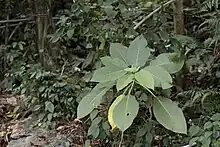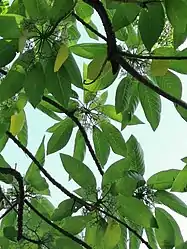| Dendrocnide meyeniana | |
|---|---|
 | |
| Scientific classification | |
| Kingdom: | Plantae |
| Clade: | Tracheophytes |
| Clade: | Angiosperms |
| Clade: | Eudicots |
| Clade: | Rosids |
| Order: | Rosales |
| Family: | Urticaceae |
| Genus: | Dendrocnide |
| Species: | D. meyeniana |
| Binomial name | |
| Dendrocnide meyeniana | |
| Synonyms | |
|
List
| |
Dendrocnide meyeniana or the poisonous wood nettle is a species of tree in the family Urticaceae, native to the thickets and secondary forests of Taiwan and the Philippines. The specific epithet meyeniana honors Franz Meyen, who collected the type specimen in Manila during his world cruise. [1]
In the Philippines, Dendrocnide meyeniana is commonly referred to as lipa, lipang kalabaw (lit. 'carabao lipa', to distinguish it from Laportea interrupta, a nettle shrub locally named lipang aso, the "dog lipa"), or more rarely, apariagua. The city of Lipa in Batangas is named after this plant. Locals distinguish it primarily by the short stinging hairs[2] on its twigs. It is also known as bulan-bulan in regions where Bisayan languages are dominant.[3]
In Taiwanese Mandarin, it is widely known as yǎoréngǒu (Chinese: 咬人狗; Pe̍h-ōe-jī: kā-lâng-káu; lit. 'biting people dog'), a name which has been used since the early Qing period referring to the skin irritation or inflammation its stinging hairs may cause.[4][5] Among the Taiwanese indigenous peoples, it is known as valjulu by the Paiwan people,[6] and as lingatren by the Puyuma people;[7] both ethnic groups have the custom of whipping adolescents with the plant as a rite of passage or a corporal punishment.[6][8]
Medicinal importance
The poisonous wood nettle may cause acute dermatitis when the skin gets into contact with the stinging hairs on its leaves,[9] or other parts such as stems or inflorescences. The fruit and receptacle are edible, but the stalk is not, because it is covered with stinging hairs. The stinging hairs of D. meyeniana are short and hard to see. Although the leaves are densely covered with stinging hairs, they are invisible to the eyes.[10]
In Philippine traditional medicine, the tree's sap is prepared as a drink for improving the production of breast milk. Its roots and leaves can also be used as a diuretic.[11]
Gallery
 Axillary inflorescences. Dioecious.
Axillary inflorescences. Dioecious. Leaves alternate, clustered at the ends of the branches.
Leaves alternate, clustered at the ends of the branches. Obvious lenticels
Obvious lenticels Trunk light brown, straight.
Trunk light brown, straight.
References
- ↑ Walpers, W. G. (1843). "Adnotatio". Nova Acta Physico-Medica Academiae Caesareae Leopoldino-Carolinae Naturae Curiosorum (in Latin). 19 (Suppl. 1): 297–495.
- ↑ Castro, I. R. (2006). A Guide to Families of Common Flowering Plants in the Philippines. Quezon City: University of the Philippines Press. p. 176. ISBN 978-971-542-525-4. Retrieved 3 May 2022.
- ↑ "Lipa". STUARTXCHANGE. Retrieved 4 May 2022.
- ↑ Huang, S.-J. (1736). 臺海使槎錄 [Records from the Mission to Taiwan and its Strait] (in Chinese). Vol. 3.
治痔漏:三腳虎草、三腳鱉草、咬人狗、虎尾崙。
- ↑ Fan, X., ed. (1747). 重修臺灣府志 [Revised Gazetteer of Taiwan Prefecture] (in Chinese). Vol. 18.
咬人狗,其木甚鬆,手搯之,便長條迸起;可為火具。高丈餘。葉長大似烟葉,有毛刺;刺人入毛孔甚癢,痛搔發紅腫,一晝夜方止。
- 1 2 Cheng, H.-W.; Wang, H.-H.; Cheng, H.-F.; Lai, H.-Y., eds. (2004). 排灣族民族植物 [Paiwan Ethnobotany] (PDF) (in Chinese (Taiwan)). Taipei: Taiwan Forestry Research Institute, Council of Agriculture. p. 190. ISBN 957-01-8642-9.
- ↑ Lin, H.-F.; Yang, M.-H., eds. (2021). 你是我的菜:利卡夢生活植物 [Plants in Rikavon Daily Life] (in Chinese (Taiwan)). Taipei: Taitung Forest District Office, Forestry Bureau. ISBN 978-986-5455-17-0.
- ↑ 林育世 (August 31, 2000). "台東達魯瑪克部落豐年祭" (in Chinese (Taiwan)). 今周刊.
- ↑ Chang, Y.-T.; Shen, J.-J.; Wong, W.-R.; Yen, H.-R. (2009). "Alternative Therapy for Autosensitization Dermatitis". Chang Gung Medical Journal. 32 (6): 668–673. CiteSeerX 10.1.1.628.6388. PMID 20035647.
- ↑ 林育安. "有毒植物 焮毛細小而肉眼不易察覺的咬人狗" (in Chinese (Taiwan)). 行政院農業委員會. Retrieved 2022-12-04.
- ↑ Williams, C. (2012). Medicinal Plants in Australia Volume 3: Plants, Potions and Poisons. Kenthurst, N.S.W.: Rosenberg Publishing. p. 57. ISBN 978-1-925078-07-7. Retrieved 3 May 2022.
External links
 Media related to Dendrocnide meyeniana at Wikimedia Commons
Media related to Dendrocnide meyeniana at Wikimedia Commons